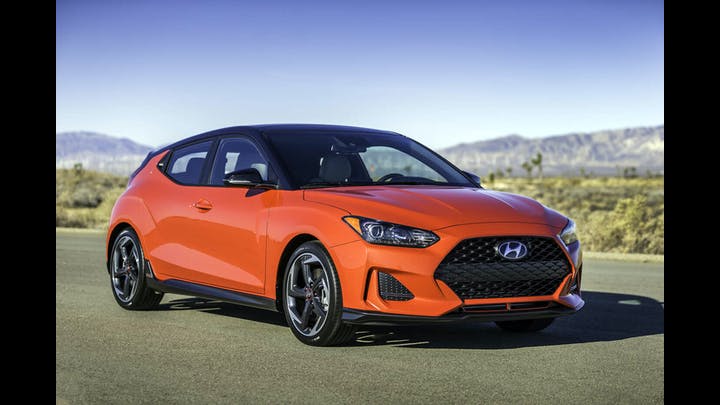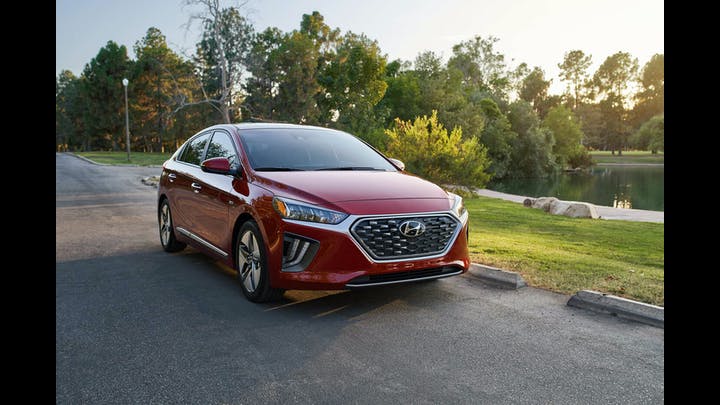
With a unique three-door design and powerful engine options, this tiny hatchback is ideal for city driving. Despite some low-quality interior features, it’s a fun and exciting automobile that will make you look forward to your everyday commute.
Overview
The Hyundai Veloster is a cute little hatchback with a lot of character. It comes with a variety of powerful turbocharged engines that make it exhilarating and enjoyable to drive. Seating for four people is available, although the back seats aren’t designed for much more than short journeys. This automobile is ideal for singles or couples looking for a low-cost, high-performance hatchback. Its hatchback configuration allows it to carry a surprising amount of stuff, and the third door makes stowing items in the back seats much easier. Key communication capabilities are included in the infotainment system, and the basic safety technology is remarkable. Its drawbacks include mediocre fuel economy and a low-quality cabin. There is less storage space, less rear-seat legroom, and no turbocharged engines in the Toyota Corolla Hatchback. The Honda Civic Hatchback’s turbocharged engines are less powerful, but it has more storage space and rear legroom.
Trims and Costs
The Veloster comes in six trim levels: 2.0, 2.0 Premium, Turbo R-Spec, Turbo, Turbo Ultimate, and N, all of which are front-wheel drive exclusively. Although the N is the most popular trim, we favor the Turbo. We’ll explain why in a moment.
2.0
The base trim starts at $19,905 (with a $1,005 destination charge). A 2.0-liter four-cylinder engine, six-speed manual transmission, 17-inch wheels, sunroof, leather seats, 7-inch infotainment display, Apple CarPlay, Android Auto, forward-collision warning, and lane-keeping assist are all included as standard features. Optional is a six-speed automatic transmission with paddle shifters.
Premium 2.0
This model includes 18-inch wheels, a six-speed automatic transmission, cloth seats with leather bolsters, heated front seats, an 8-inch infotainment touchscreen, and premium eight-speaker audio for a starting price of $24,105. Wireless charging, leather-wrapped shift knob and steering wheel, blind-spot warning, and rear cross-traffic alert are also included in the 2.0 Premium.
R-Spec Turbo
The Turbo R-Spec adds a more powerful 1.6-liter turbocharged four-cylinder engine, a six-speed manual transmission, LED headlights and taillights, Gloss Black exterior elements, luxury cloth seats, alloy wheels, and high-beam assist to the base model, which starts at $24,455.
Turbo
The Turbo is our favorite because of its 1.6-liter turbocharged engine and seven-speed automated transmission. If you’re one of the few people who still prefers a manual transmission, the Turbo R-Spec is the way to go.
A standard seven-speed dual-clutch automatic transmission, special fabric seats with leather bolsters, and a perforated leather-wrapped steering wheel are included in the Turbo ($26,755) specification.
Ultimate Turbo
The Turbo Ultimate comes standard with a two-tone black roof, leather seating surfaces with Turbo stitching on the front seatbacks, navigation, HD radio, head-up display, forward-collision warning with pedestrian recognition, and rain-sensing wipers, with a starting price of $29,455.
N
A 2.0-liter turbocharged four-cylinder engine, six-speed manual transmission, 19-inch wheels, fabric seats with leatherette bolsters, and an adjustable suspension are included in this performance-oriented model ($33,255). Optional is an eight-speed dual-clutch automatic transmission.
It comes in a variety of trim levels with a variety of engines and transmissions to accommodate practically every driver. The Toyota Corolla Hatchback is available in only three model levels, none of which include a turbocharged engine. The Honda Civic Hatchback comes in four turbocharged models, although they aren’t as powerful as the Veloster.
Performance and Engine
The Hyundai Veloster comes standard with a 2.0-liter four-cylinder engine and a six-speed manual or automatic transmission with paddle shifters. The 2.0-liter engine produces 147 horsepower and is a lot of fun to drive, especially with the manual transmission. For quick acceleration, this compact car doesn’t need a lot of horsepower, which makes highway merges a breeze. The steering is precise, and the ride is smooth and free of road or wind noise.
A 1.6-liter turbocharged four-cylinder engine with a six-speed manual or a seven-speed automatic transmission with paddle shifters is the next option. Its significant increase in horsepower to 201 hp makes it a more performance-oriented alternative. It easily accelerates to highway speeds and has plenty of power to pass slower vehicles. The engine makes somewhat more noise than the original engine, but it’s neither distracting or unpleasant.
The 2.0-liter turbocharged four-cylinder engine, which is exclusively available in the Veloster N, is mated to either a six-speed manual or an eight-speed dual-clutch automatic transmission. This is the most responsive and entertaining option of the bunch, with 275 hp. While the other engine options, particularly the 1.6-liter, are good, anyone looking for a true performance hatchback should pick for the turbocharged 2.0-liter. There’s more engine noise, but it’s appropriate for a sports car.
The Toyota Corolla Hatchback has only one non-turbocharged engine choice that produces 168 horsepower. The Mazda 3 comes with three engines, although the turbocharged version falls short of the Veloster’s most powerful engine. The Honda Civic Hatchback comes standard with two turbocharged engines that produce more horsepower than the Veloster’s base engine but less than either of the alternative engines. The Honda Civic Type R has 306 horsepower for even more power.
Interior
Because the Hyundai Veloster is a small hatchback, the inside feels cramped. There is seating for four people, and a third door makes it easier to get into the back seats. However, the back seat is still a pretty tight fit, so it’s best for short trips. The front seats are comfortable, with plenty of bolstering to keep you in position while not being overly confining for larger individuals. Although the seating position is low, as befitting a sporty hatchback, taller adults may find the headroom inadequate. The materials used in the seating are comfortable. However, even in its higher trims, the Veloster’s cabin has an unappealing amount of plastic. With 19.9 cubic feet behind the rear seats and 44.5 cubic feet behind the front seats, there’s a surprising amount of cargo space. The Toyota Corolla Hatchback boasts higher-quality materials and a more upright seating position, which some people prefer. In addition, the Honda Civic Hatchback has higher-quality materials throughout, making it more appealing and premium. With a higher starting price, the Mazda 3 delivers a premium interior.

